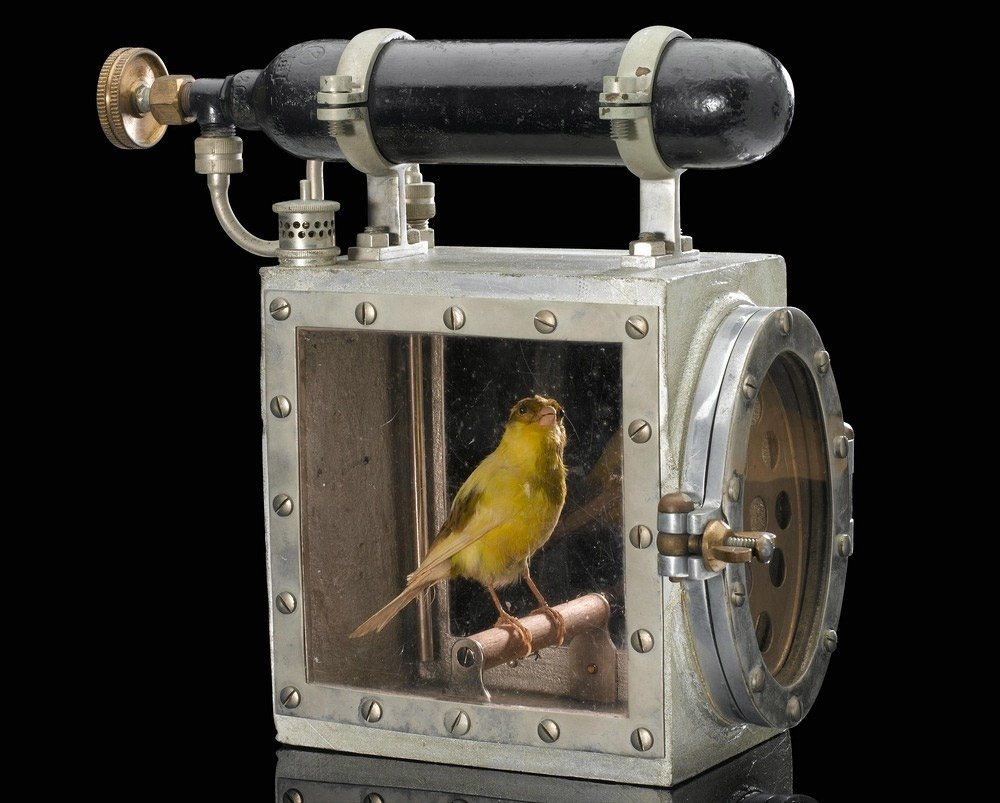?Did you know how the beautiful and innocent “canaries” were used as toxic gas detectors in European countries

Working in mines is considered one of the most difficult professions in our lives for many reasons, the first of which is the nature of work underground and at great depths, which may threaten their lives first by sudden collapses of the earth’s layers and the workers being trapped in their mines and unfortunately the end of their lives may be in their workplaces.
But the danger does not stop there because there are invisible dangers such as toxic gas emissions or a sudden increase in the percentage of carbon oxides in these mines that cannot be perceived because these gases are mostly invisible and do not have distinctive odors.
Given the rapid response of birds, especially canaries, to these types of gases, they were used as warning devices by placing them in resuscitation devices equipped with oxygen cylinders to save them immediately when symptoms of poisoning begin and to warn the workers around them to evacuate.
When an accident occurs in a mine, rescue and relief workers descend into the mine, taking canaries with them into glass rooms like the one in the picture above.
Underground mines can contain a lot of toxic and deadly gases such as carbon monoxide that are formed during various accidents such as fires or explosions.
This odorless and colorless gas is extremely deadly to both canaries and humans, but what distinguishes canaries from humans in this case is that they are more exposed to the danger of this gas, and thus they show rapid and visible reactions in response to their exposure to it compared to humans, which is why miners take them with them into the mines to warn them in the event of a deadly gas leak.
When an accident occurs in a mine, rescue and relief workers descend into the mine, taking with them the canaries in the previously mentioned resuscitation devices. The metal and glass box contains a small circular door on the front that is open to allow outside air to enter the box. At the same time, a small fence covers the opening, which acts as a barrier to prevent the bird from escaping. If carbon monoxide gas is present in the air, the canary begins to show symptoms of exposure by swinging conspicuously inside the box and eventually falling to the floor. Here, the worker closes the door of the opening that allows air to enter, then opens the valve of the cylinder containing oxygen that penetrates into the box and revives the bird and brings it back to life. Then the miners evacuate the danger area.

A miner holds a canary resuscitator
The idea of using canaries to detect leaks of toxic and deadly gases was first proposed by the Scottish physiologist John Scott Haldane, born in 1860, who was famous for his discovery of the physiology of respiration and the nature of gases and their effects on the human body.
Haldane would lock himself in sealed chambers and expose himself to various cocktails of deadly gases, while taking notes recording his experience of being slowly poisoned and what it looked like.
During World War I, Haldane traveled to the front lines with soldiers to identify the deadly poison gas used by the Germans, and from there he invented the world's first gas mask. Haldane also conducted many investigations into mine disasters, and discovered that carbon monoxide was a very deadly compound that killed most of the miners after he noticed that all of their bodies had pink spots due to a compound that forms in the blood when carbon monoxide combines with hemoglobin.
In his early experiments in the late 1890s, Haldane experimented on small animals such as white mice and canaries. He chose these small animals in particular because they had a faster metabolism than humans—that is, they burned calories faster than we humans—and so showed symptoms of carbon monoxide exposure earlier, even in very small amounts. Canaries were the best of these animals in this regard, in particular, due to their unique respiratory system.
Just like all birds, canaries have a very complex respiratory system that has evolved to collect as much oxygen as possible from the air. This is a very important feature for birds because the process of flying requires a lot of energy, and birds often fly at high altitudes where there is very little oxygen.

Diagram showing the difference between the respiratory systems of humans and birds
When a bird inhales, it takes in a large amount of air relative to its size—the bird's respiratory system is 20 percent of its total volume, compared to our human respiratory system, which makes up 5 percent of our bodies. Some of the air taken in when it inhales is stored in small empty spaces called "air pockets" that are distributed throughout the bird's body. The rest of the inhaled air is directed to the lungs, where oxygen is replaced by carbon dioxide.
When exhaling, the air stored in the air sacs in the bird's body enters the lungs where carbon dioxide is replaced with oxygen as well. Therefore, birds breathe oxygen constantly, whether inhaling or exhaling, which makes them at the top of the list when it comes to inhaling oxygen, and also makes them more vulnerable to dangers in the event of the presence of toxic gases in the air.
The use of canaries in mines was officially banned in Britain in 1986, and is considered a punishable offence. Shortly before this law was passed, miners were using about 200 canaries as toxic gas detectors. These birds were later replaced by cheaper, more effective and more humane electronic devices.

Canary resuscitator, which was used to detect poisonous gases.
?Would you accept the idea of working or going down to visit one of these mines and visit or work in them
Source: websites

